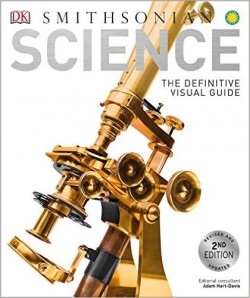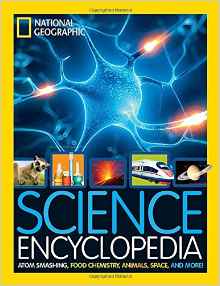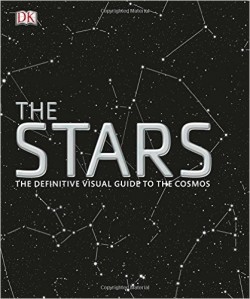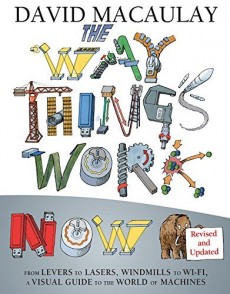2018 School Spending Survey Report
Seriously STEM | Spectacular Visual Guides for the Classroom and Library
Stunning photography, 3-D illustrations, and learner-friendly formatting distinguish a crop of new and updated science compendiums.
 Associated with the Smithsonian and its wealth of archives, Science: The Definitive Visual Guide, 2nd ed. (DK, 2016; Gr 9 Up), is the heftiest compendium of the lot, and takes a broad look at the “whole of science and its history.” The chronological presentation—from prehistory to the present day—is arranged into commonly recognized eras such as "Renaissance & Enlightenment," "Industrial Revolution," and "Information Age." The first page of each section hints at the most defining discoveries of the period, such as quantum theory during the "Atomic Age." As a clever alternative to a table of contents, a calendar time line provides a bird's-eye look at the entries to follow. Tabs across the top of pages keep track of the dates as the topics progress from “Early Metalworkers” to “Tackling Climate Change.” Photos, illustrations, and text are strategically placed on the double-page entries to lead the eye through the subject's logical components. For example, “Immunizations and Vaccination” begins with the "before" practices of inoculation and early tools used to pierce the skin, followed by a narrative on Louis Pasteur’s work, diagrams of immune response, and "after" information about immunization programs and current opt-out controversies. Earmarked biographical entries are fascinating, such the section on Nobel Prize-winner Dorothy Hodgkin, who is portrayed as a well-loved teacher—beyond her work with crystals, insulin structure, and vitamin B12. More than 50 pages of reference tools, including information on scientific classification, earthquake zones, human body systems, a table of elements, physics formulas and equations, and more are appended. The book's organization and access features, such as the time line introductions, color tabs, and indexing, all serve as useful guides for young researchers.
Associated with the Smithsonian and its wealth of archives, Science: The Definitive Visual Guide, 2nd ed. (DK, 2016; Gr 9 Up), is the heftiest compendium of the lot, and takes a broad look at the “whole of science and its history.” The chronological presentation—from prehistory to the present day—is arranged into commonly recognized eras such as "Renaissance & Enlightenment," "Industrial Revolution," and "Information Age." The first page of each section hints at the most defining discoveries of the period, such as quantum theory during the "Atomic Age." As a clever alternative to a table of contents, a calendar time line provides a bird's-eye look at the entries to follow. Tabs across the top of pages keep track of the dates as the topics progress from “Early Metalworkers” to “Tackling Climate Change.” Photos, illustrations, and text are strategically placed on the double-page entries to lead the eye through the subject's logical components. For example, “Immunizations and Vaccination” begins with the "before" practices of inoculation and early tools used to pierce the skin, followed by a narrative on Louis Pasteur’s work, diagrams of immune response, and "after" information about immunization programs and current opt-out controversies. Earmarked biographical entries are fascinating, such the section on Nobel Prize-winner Dorothy Hodgkin, who is portrayed as a well-loved teacher—beyond her work with crystals, insulin structure, and vitamin B12. More than 50 pages of reference tools, including information on scientific classification, earthquake zones, human body systems, a table of elements, physics formulas and equations, and more are appended. The book's organization and access features, such as the time line introductions, color tabs, and indexing, all serve as useful guides for young researchers.  “Science is the way humans figure out how everything in the world works,” is the definition that sets the tone for middle graders eager to make connections between science and their lives. Science Encyclopedia: Atom Smashing, Food Chemistry, Animals, Space, and More! (National Geographic, 2016; Gr 3-8) delivers information to students under two main divisions, "Physical Science" and "Life Science." Color tabs, bold headings, and boxed content aid navigation in chapters on "Matter," "Energy," "Forces & Machines," and "Electronics," where entries as simple as “Water,” or “Heat,” sit side-by-side with more difficult concepts, such as “Bending Light.” In this last instance, captioned photos of a rainbow, a seemingly broken-looking straw in a glass of water, and a cat unsuccessfully trying to touch goldfish in a fish bowl—go a long way in aiding readers' comprehension about light refraction. In "Life Science," readers can leaf through entries on galaxies, biomes, ancient medicine, and the like, in chapters on "The Universe," "Life on Earth," "Planet Earth," and "The Human Body." The small font allows room for loads of facts and content-specific vocabulary, but it's the wealth of colorful, kid-centric photos that grab the eye and stimulate the mind (just try skipping over the full-page grinning, human-like salamander called Axolotis or “walking fish”). The chunking and color blocking of information encourages readers to pick and choose what interests them; in turning pages, they may stumble upon a riddle, or simple “Try This!” experiment. An appended glossary, list of further resources and web sites, and index add to the volume's research potential.
“Science is the way humans figure out how everything in the world works,” is the definition that sets the tone for middle graders eager to make connections between science and their lives. Science Encyclopedia: Atom Smashing, Food Chemistry, Animals, Space, and More! (National Geographic, 2016; Gr 3-8) delivers information to students under two main divisions, "Physical Science" and "Life Science." Color tabs, bold headings, and boxed content aid navigation in chapters on "Matter," "Energy," "Forces & Machines," and "Electronics," where entries as simple as “Water,” or “Heat,” sit side-by-side with more difficult concepts, such as “Bending Light.” In this last instance, captioned photos of a rainbow, a seemingly broken-looking straw in a glass of water, and a cat unsuccessfully trying to touch goldfish in a fish bowl—go a long way in aiding readers' comprehension about light refraction. In "Life Science," readers can leaf through entries on galaxies, biomes, ancient medicine, and the like, in chapters on "The Universe," "Life on Earth," "Planet Earth," and "The Human Body." The small font allows room for loads of facts and content-specific vocabulary, but it's the wealth of colorful, kid-centric photos that grab the eye and stimulate the mind (just try skipping over the full-page grinning, human-like salamander called Axolotis or “walking fish”). The chunking and color blocking of information encourages readers to pick and choose what interests them; in turning pages, they may stumble upon a riddle, or simple “Try This!” experiment. An appended glossary, list of further resources and web sites, and index add to the volume's research potential.  Students (and grown-ups!) will lose themselves in brilliant full-page photos, of swirling starscapes and “spiderlike nebulas that shine from throwing jets of material that create shock waves in the gas” in The Stars: The Definitive Visual Guide to the Cosmos (DK, 2016; Gr 5 Up). An engaging narrative leads students through the first section, “Understanding the Cosmos,” which provides the analogy of “currents in a cake moving apart as the batter rises in the oven,” in explaining the concept of an expanding universe. The friendly, yet instructive writing style continues when describing the vast “soup” of tiny interacting particles that formed out of the intense energy of the Big Bang, and even more impressive is the double-page 3-D illustration depicting its stages. In the section on "Constellations," blue-toned graphics of nearly 60 star patterns note the names of the stars connected by lines, with an artistic rendering of the mythological figure represented superimposed on the pages. It is a meaty section, and the level of detail makes this reference an indispensable guide for stargazers. The chapter on the "Solar System" is much more spare; planets are grouped together as outer planets or inner planets, followed by individual pages on the Sun and the Moon. However, close-up photos of sunspots, moon craters, Jupiter's granite-like bands, are crystal clear and space-buff worthy. A detailed reference section offers star charts, sky patterns (the sky is divided into 88 areas), Messier objects (Charles Messier was a comet hunter), galaxy groups, glossary, and a general index that includes every star referenced.
Students (and grown-ups!) will lose themselves in brilliant full-page photos, of swirling starscapes and “spiderlike nebulas that shine from throwing jets of material that create shock waves in the gas” in The Stars: The Definitive Visual Guide to the Cosmos (DK, 2016; Gr 5 Up). An engaging narrative leads students through the first section, “Understanding the Cosmos,” which provides the analogy of “currents in a cake moving apart as the batter rises in the oven,” in explaining the concept of an expanding universe. The friendly, yet instructive writing style continues when describing the vast “soup” of tiny interacting particles that formed out of the intense energy of the Big Bang, and even more impressive is the double-page 3-D illustration depicting its stages. In the section on "Constellations," blue-toned graphics of nearly 60 star patterns note the names of the stars connected by lines, with an artistic rendering of the mythological figure represented superimposed on the pages. It is a meaty section, and the level of detail makes this reference an indispensable guide for stargazers. The chapter on the "Solar System" is much more spare; planets are grouped together as outer planets or inner planets, followed by individual pages on the Sun and the Moon. However, close-up photos of sunspots, moon craters, Jupiter's granite-like bands, are crystal clear and space-buff worthy. A detailed reference section offers star charts, sky patterns (the sky is divided into 88 areas), Messier objects (Charles Messier was a comet hunter), galaxy groups, glossary, and a general index that includes every star referenced.  A similar treatment for a younger audience, Space Visual Encyclopedia (DK, 2016; Gr 3-6), dispenses less detailed, but essential, information utilizing the visual appeal of crisp photography, infograms, and text boxes. Students can learn about space, our solar system, the scientists who studied the universe, space exploration, or try their hand at locating the constellations. This compact volume provides cutaway graphics to depict the layers and internal features of a space suit; or the core, mantle, surface, and atmospheric layer of each planet. “Data File” boxes provide quantified information such as sizes, dates, and distances in light years. A final reference section includes a time line with photo insets for selected events, such as the most recent flyby of the dwarf planet, Pluto, on July 14, 2015. Space missions by other players, including Russia, China, and the European Space Agency, present students with examples of global participation and joint efforts, such as the International Space Station. Appended items include a glossary, index, map of the World’s Space Agencies, and Amazing Space Facts—who knew that “Space junk,” such as broken satellites and tools, travels 10 times faster than a bullet? Overall, an enticing first pick for young space enthusiasts.
A similar treatment for a younger audience, Space Visual Encyclopedia (DK, 2016; Gr 3-6), dispenses less detailed, but essential, information utilizing the visual appeal of crisp photography, infograms, and text boxes. Students can learn about space, our solar system, the scientists who studied the universe, space exploration, or try their hand at locating the constellations. This compact volume provides cutaway graphics to depict the layers and internal features of a space suit; or the core, mantle, surface, and atmospheric layer of each planet. “Data File” boxes provide quantified information such as sizes, dates, and distances in light years. A final reference section includes a time line with photo insets for selected events, such as the most recent flyby of the dwarf planet, Pluto, on July 14, 2015. Space missions by other players, including Russia, China, and the European Space Agency, present students with examples of global participation and joint efforts, such as the International Space Station. Appended items include a glossary, index, map of the World’s Space Agencies, and Amazing Space Facts—who knew that “Space junk,” such as broken satellites and tools, travels 10 times faster than a bullet? Overall, an enticing first pick for young space enthusiasts.  David Macaulay's acclaimed The Way Things Work (1988) and The New Way Things Work (1998) offered readers a look inside the workings of gadgets and machines through text and detailed illustrations. The master is back with the revised and updated The Way Things Work Now ( 2016, all HMH; Gr 4 Up), covering five broad categories of devices and machinery from "The Mechanics of Movement" to the "Digital Domain," and information on the "Invention of Machines." Some entries from the earlier editions are gone (tape recorder, compact disc players, etc.) making way for microchips, smart phones, hybrid cars, and other items of interest. The illustrated, accessible explanations are presented on full pages, and often, across spreads. Color highlights, arrows, and labels as well as fonts of varying sizes and an engaging layout support the Macaulay's dynamic line drawings and the clear text, written with Neil Ardley. As in the earlier titles, Macaulay makes connections between the principles and objects selected; for example, how the "zipper cleverly exploits the principle of the inclined plane to join or separate two rows of interlocking teeth," or noting that the epicyclic gear (also referred to as the sun-and-planet gear) is found in "salad spinners, automatic transmissions, and many other devices." The woolly mammoth of earlier editions is also here, aiding the author in explanations and analogies, and, of course, providing a bit of fun. The Way Things Work Now is a book that demands both attention and a spot on every classroom shelf. Be sure to make room for it, alongside the other books included here.
David Macaulay's acclaimed The Way Things Work (1988) and The New Way Things Work (1998) offered readers a look inside the workings of gadgets and machines through text and detailed illustrations. The master is back with the revised and updated The Way Things Work Now ( 2016, all HMH; Gr 4 Up), covering five broad categories of devices and machinery from "The Mechanics of Movement" to the "Digital Domain," and information on the "Invention of Machines." Some entries from the earlier editions are gone (tape recorder, compact disc players, etc.) making way for microchips, smart phones, hybrid cars, and other items of interest. The illustrated, accessible explanations are presented on full pages, and often, across spreads. Color highlights, arrows, and labels as well as fonts of varying sizes and an engaging layout support the Macaulay's dynamic line drawings and the clear text, written with Neil Ardley. As in the earlier titles, Macaulay makes connections between the principles and objects selected; for example, how the "zipper cleverly exploits the principle of the inclined plane to join or separate two rows of interlocking teeth," or noting that the epicyclic gear (also referred to as the sun-and-planet gear) is found in "salad spinners, automatic transmissions, and many other devices." The woolly mammoth of earlier editions is also here, aiding the author in explanations and analogies, and, of course, providing a bit of fun. The Way Things Work Now is a book that demands both attention and a spot on every classroom shelf. Be sure to make room for it, alongside the other books included here. RELATED
RECOMMENDED
CAREERS
The job outlook in 2030: Librarians will be in demand
CAREERS
The job outlook in 2030: Librarians will be in demand
ALREADY A SUBSCRIBER? LOG IN
We are currently offering this content for free. Sign up now to activate your personal profile, where you can save articles for future viewing






Add Comment :-
Be the first reader to comment.
Comment Policy:
Comment should not be empty !!!